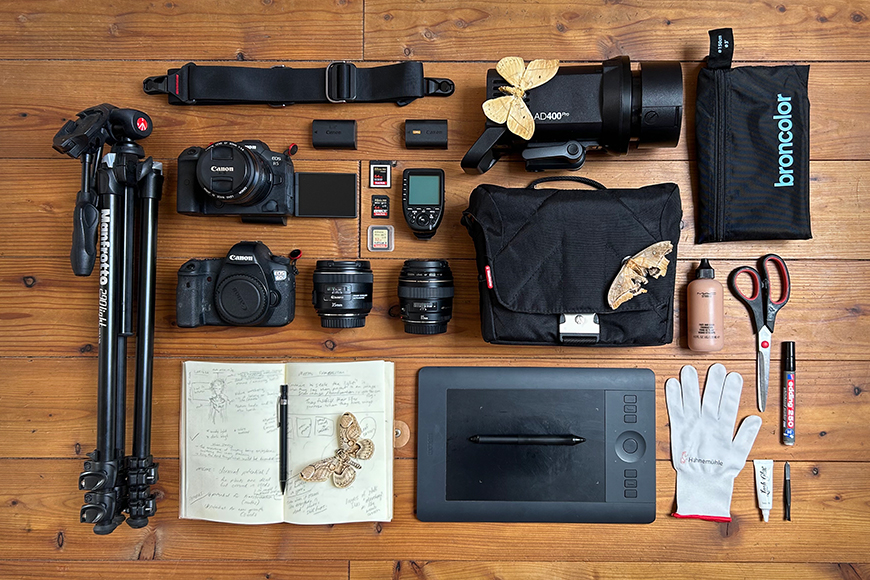







Leigh Schneider
Fine Art | Last Updated: July 26, 2023
Hi, I’m Leigh Schneider and I’m a Conceptual Fine Art Photographer, from New Zealand. I mostly shoot portraiture and while my work appears dark, my concepts use symbolism to ignite a hopeful vision for the future.
I started working seriously with my art in 2017 when a house robbery resulted in the loss of all of my work as a Graphic Designer and I reinvested the insurance payout into my first full-frame camera, which was the Canon EOS 6D.
I worked with this camera for a few years, shooting almost exclusively with the Canon 85mm f/1.8 lens.
I mostly shot outdoors at this time and loved that I could achieve sharp portraits with beautiful bokeh with this setup. I also used the Canon 35mm f/2 lens when I wanted to include more of the surrounding area in the frame.
As my style evolved and I realised I wanted to print limited editions of my work, I needed to upgrade my camera. This was to create large-scale artworks and take commissions for clients who had greater demands on image quality.
I chose the Canon EOS R5 with a mount adapter, in order to continue using my EF lenses with the RF system. I love this camera as the quality is incredible and the eye tracking feature especially helps me to focus more on the mood and composition of the image when creating, instead of technical functionality.
I still use my Canon EOS 6D to capture behind-the-scenes footage.
While I continued to shoot outdoors, I also began working more in the studio. I added the Canon 50mm f/1.4 lens to my kit and haven’t looked back. I still use all my lenses, depending on the shoot, but this has become a favourite.
It allows me to work in tight and large spaces alike and generates natural-looking compression on my subjects.
I have two studio strobes; both Godox AD400Pros, which I love, because not only are they affordable, they are consistent and portable. I can take them outdoors with ease and work indoors without cables getting in the way.
I use them with the Godox XProC Trigger and shoot against Colorama paper backdrops.
My modifiers are Broncolor; my absolute favourite is the Octabox 150, which creates soft, painterly light with good contrast on its own. For fill, variety and male subjects I have the Softbox 60×100.
I also use a Neewer 110cm 5 in 1 Reflector, to fill and add additional catchlights.
For shoots that require more extensive composite work, I use the Manfrotto 290light tripod. It enables me to capture the scene without shifting the background and is lightweight for on-location shoots.
The Peak Design Slide Camera Strap is part of my kit for outdoor shoots which provides extra security when there is no safe place to put your camera down.
It’s so easy to adjust and has an amazing attachment system, that allows me to clip it on and off or switch it to my other camera super fast.
My Manfrotto Bella V Shoulder Bag is my preferred choice for transporting my gear, since it’s small and compact, while still somehow magically fitting my camera, all my lenses and other small bits and bobs.
The shoulder bag allows me to not be weighed down when on location plus I also have the Neewer MID#0730815 backpack, for when I need to pack heavier. It’s budget-friendly and still in perfect condition after six years of use.
I edit my work with the Wacom Intuos Pro and couldn’t imagine not having one. It allows for detailed and accurate retouching work.
I use Photoshop to edit my work, on the Eizo CG2420, which is critical for print accuracy and when retouching details, I work on my higher-resolution iMac screen.
I also have an enormous Amazon whiteboard, which is a critical part of my setup. I’ve named it my ‘brain,’ as it helps me to see my to-do list visually and make sure I have everything in mind before shooting.
My notebook is also always in attendance, detailing my concepts and goals for the shoot.
The scissors in my kit represent the craft aspect of my artwork and help with any minor nature clean-ups that may be needed.
I’ve included Mac’s Studio Face And Body Foundation in my kit, as I usually do my own styling. This foundation is perfect to create a natural, yet flawless finish and is used in almost all my work.
The gloves by Hahnemühle represent the creation of my limited edition prints and are an important part of finishing my artwork. I work with their paper, for its high-end reputation and superior quality.
Important to my kit are my moths, which I love to use, even as hidden elements in my work. I have lash glue by Benefit and a pair of ancient Manicure tweezers, to handle and place them on my subjects or the surrounding area.
A large water bottle, snacks to avoid hangriness for myself or the model and a cheap Amazon jumpsuit are also usually present as my shoots can get messy!
Overall, you can create solid work with very little gear. I started out with just one lens and shooting in natural light.
I recommend starting simple, getting to know yourself and your style and then adding only what you need along the way. It’s a real bummer to have an expensive piece of gear in your kit, that you never use.
I always choose budget-friendly where I can, but also appreciate leading brands and the consistency, ease of use and quality they bring to the areas I don’t like to compromise on.
Putting together the right kit, is a balancing act as unique as the photographer!

Check out these 8 essential tools to help you succeed as a professional photographer.
Includes limited-time discounts.












